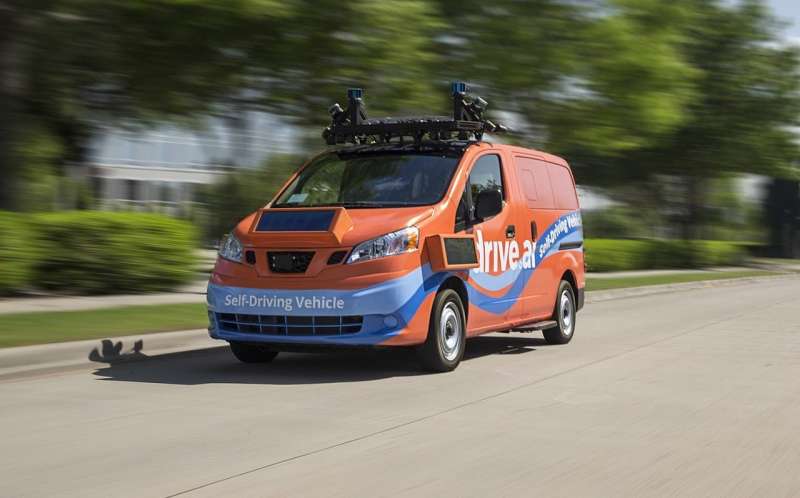May 19, 2018 weblog
Self-driving vehicle service in Frisco, Texas, to start in July

The beat goes on, no turning back, as engineers and AI thinkers get us closer to alternative ways to move around that do not depend on human drivers. Drive.ai has announced an on-demand self-driving car service in Frisco, Texas, for July.
Drive.ai is all about making this a self-driving system. Initially the service will launch with safety drivers. They released videos to how the car would manage just that through roads with pedestrians and other cars.
A driverless car navigating the city streets was shown in a video published on May 16, and the company referred to it as a driverless ride-along in Texas. An augmented reality visualization in the bottom right corner showed the perception system with sensor data to identify objects—cars, pedestrians, cyclists .
A video posted on May 7 by Drive.ai features a self-driving service vehicle. A girl calls for it via her smartphone; the video shows a signpost that reads self-driving vehicle boarding area." It pulls up, she gets in the back, and she is pretty cool about the whole thing, just another day in a driverless taxi, and she pulls out a paperback to read.
The van stops to allow a pedestrian to cross. There is even a sign on the vehicle, "Waiting for you to cross."
As long as the 10,000 local residents in the small area of mostly office parks and restaurants feel good to go, then they will be treated to a good deal.
They will gradually receive access to Drive.ai's app, with which they can hail the car to drive them around for free, said Evan Ackerman in IEEE Spectrum.
Digital Trends said, "At the start, the six-month pilot will offer free rides inside a geofenced area containing retail, entertainment, and office space, and use fixed pickup and drop-off locations. The scheme marks the first time for regular Texans to use such a driverless taxi service."
Why Texas? Drive.ai CEO Sameep Tandon told IEEE Spectrum that with its "very clear regulatory stance," it was easy for the company to work within the state. Why Frisco, Texas? Tandon said it was a good testing ground with transportation needs they could address. He characterized the needs as "short, microtransit types of rides," in taking people from work to where they relax and to where they live.
Case in point: Ackerman wrote that "someone may have to walk about 20 minutes from their office to find a restaurant for lunch, which means that an hour-long lunch break really only provides 20 minutes of scarfing time." Another case in point: parking, "somehow a challenge despite all the parking lots," said Ackerman.
All in all, the service will address a last-mile transit problem: moving between areas too far to walk but too close to drive and often too crowded to find parking.
One of the technical features: The communication panels on the vehicles. These step in to compensate for the fact that there are no human driver-pedestrian communication points such as eyeballs and hands.
Ackerman wrote, "So if an autonomous car stops at a stop sign that is also a crosswalk, how would you know that a.) the car sees you, b.) the car understands that you want to cross, and c.) the car will allow you to cross before it moves forward?"
The solution is in the form of LED displays bolted on the front, back, and sides of their cars, e.g., waiting to merge," "pulling over," and "stopping for pedestrian," and "waiting for you to cross."
Drive.ai co-founder Tao Wang said that a tricky part of the route was an intersection where the vehicles have to cross a six-lane, high-speed road without any traffic lights. Wang also noted the challenges in parking lots, where it was tough to be predictive.
So, what about risks and avoiding accidents? Tandon said in IEEE Spectrum that. "We do look at what happens, not only in self-driving car accidents but also in human-driven accidents, and we use that to help us put simulation test cases together and improve our testing process."
That is not to suggest that human intervention is totally out of the picture. It is not. It is felt that total autonomy in unstructured or even semi-structured environments would not be realistic in the short to medium term, said Ackerman.
The company is adopting a tele-choice model. What do they mean by tele-choice? A Drive.ai employee near a computer monitor can watch camera feeds from vehicles and can respond to a vehicle issue.
Here is the plan:
"In our initial rides, passengers will be joined by a safety driver, closely monitoring the vehicles' operation. We plan to soon remove the safety driver in favor of a chaperone in the passenger seat, who will educating riders about the self-driving experience and attend to the vehicle. And eventually, we will offer passenger-only rides. Throughout every phase of the program, our self-driving vehicles will be connected to our tele-choice technology, providing the ability to call to a remote operator should extra assistance be needed."
Drive.ai is focused on self-driving vehicles. Ackerman noted they are now looking at human transportation as well as logistics transportation. Drive.ai was founded by a group of graduate students out of Stanford University's Artificial Intelligence Lab.
© 2018 Tech Xplore




















